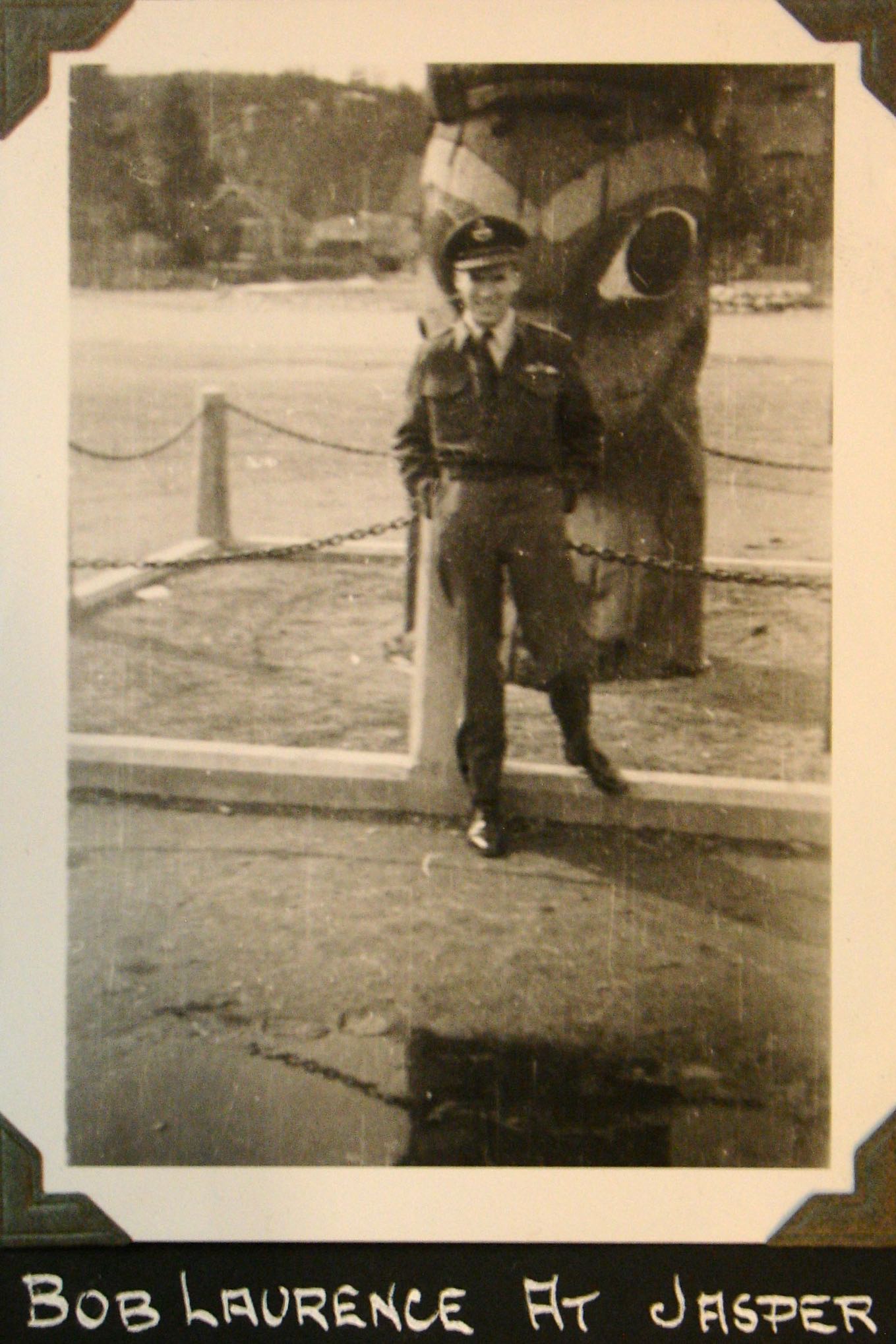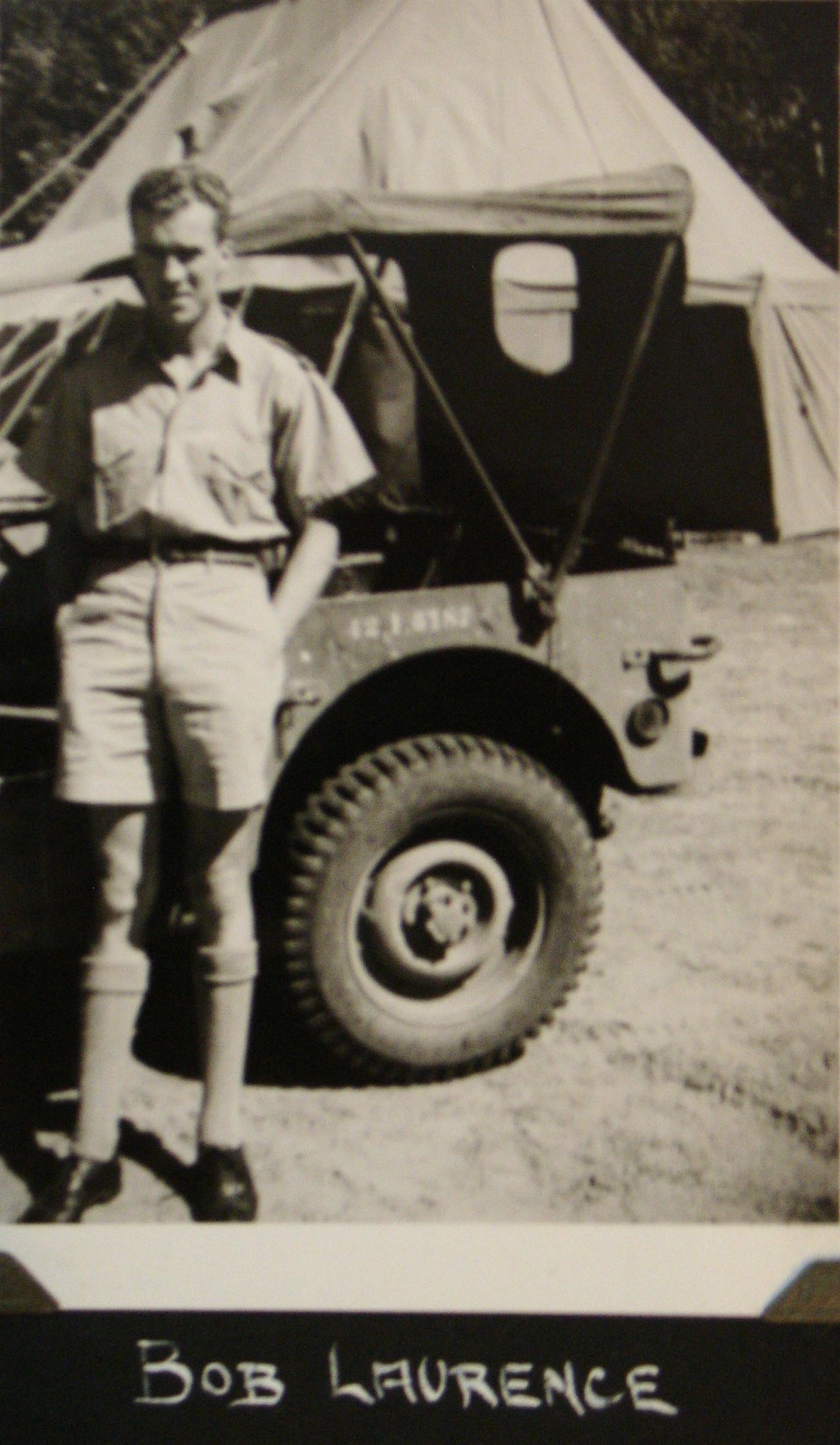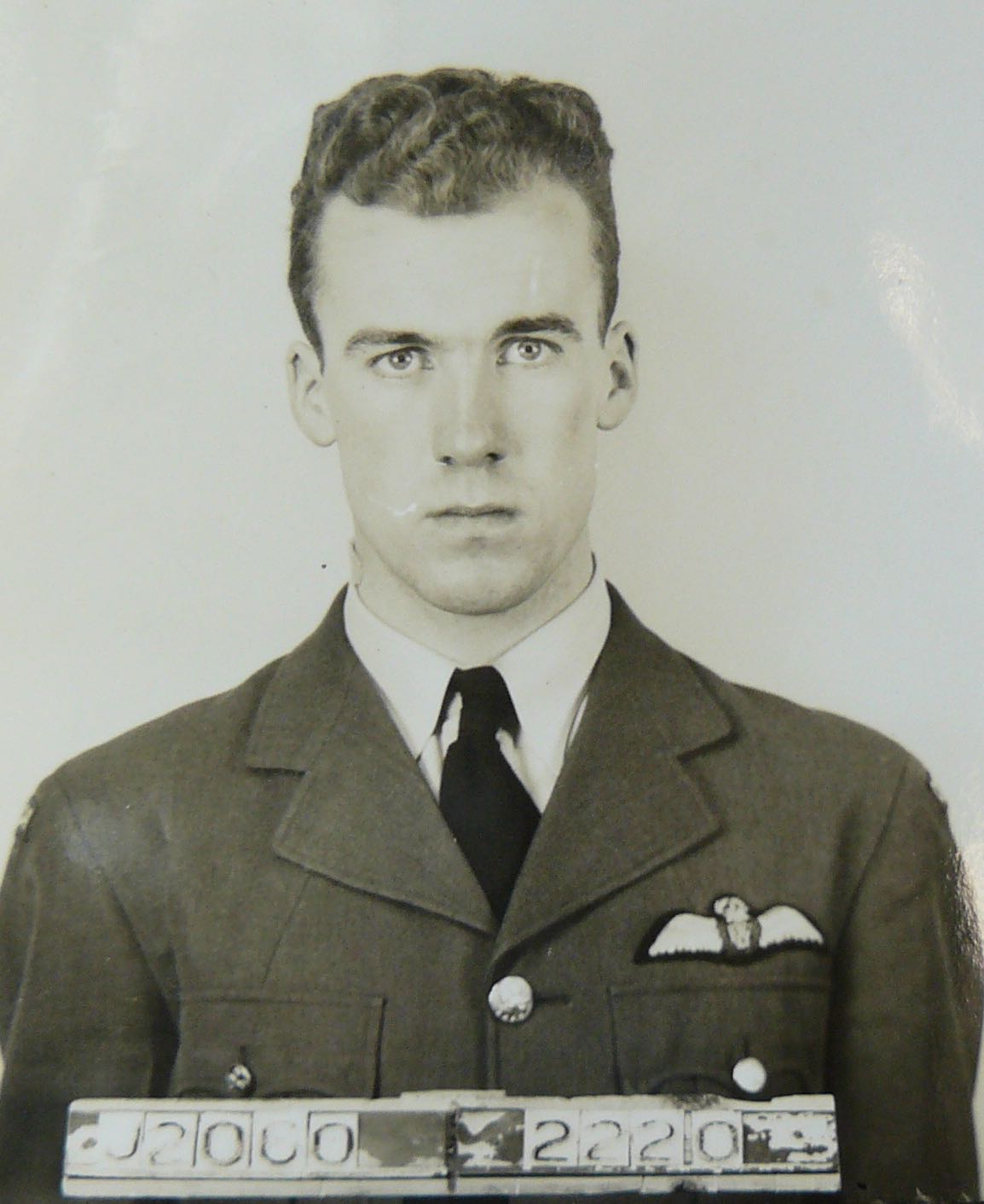


July 20, 1921 - June 3, 1993



Robert Howard Laurence was a friend of Harry Hardy. The first two photos of Bob are from Harry's personal collection.
Hugh Halliday was kind to provide the following information.
LAURENCE, F/O Robert Howard (J20602) - Distinguished Flying Cross - No.439 Squadron - Award effective 23 February 1945 as per London Gazette of that date and AFRO 563/45 dated 29 March 1945. Born 20 July 1921, South Fort St. George, British Columbia; home in Edson, Alberta (educated there 1927 to 1939). Injured while training to be a forestry worker, thereafter service station attendant, store clerk and mechanics helper. Enlisted in Edmonton, 29 September 1941. To No.3 Manning Depot, 2 November 1941; to No.10 SFTS (guard), 16 January 1942; to No.7 ITS, 28 February 1942; graduated and promoted LAC, 27 April 1942 when posted to No.19 EFTS; may have graduated 3 July 1942 but not posted to No.4 SFTS until 19 July 1942; graduated and commissioned on 6 November 1942. To No.123 Squadron, 20 November 1942; to No.163 Squadron, 16 March 1943. Promoted Flying Officer, 6 May 1943. To "Y" Depot, Halifax, 13 January 1944; embarked from New York, 21 January 1944; disembarked in Britain, 30 January 1944. To No.61 OTU, 20 February 1944. To No.3 Tactical Support Unit, 9 May 1944. Attached Honiley, 7 June 1944. To No.83 Group Support Unit, 1 July 1944. To No.439 Squadron, 20 July 1944. Promoted Flight Lieutenant, 6 November 1944; to United Kingdom, tour expired, 29 January 1945. To No.55 OTU, 26 February 1945. Repatriated 23 July 1945; released 28 September 1945. Died in Vancouver, 3 June 1992.
PL-36846 shows him. See also RCAF photo PL-41347 (ex UK-18078 dated 10 January 1945) shows him sitting on Typhoon wing after his fourth victory; caption says he was a fur trader at the Hudson Bay Company post, Fort St. James, northern British Columbia. In a letter to Carl Vincent (9 January 1977, DHist files) he describes No.163 as "a rather random collection of both aircraft and personnel, with no definitive training or operational objectives or capability". While he was there it flew five types of aircraft - Bolingbroke, Crane, Harvard, Hurricane and Kittyhawk. With flying discipline very loose, he was able to sign out aircraft almost at will. From this varied flying he learned aerobatics, formation flying and "a limited amount of gunnery that no doubt enabled me to be an effective operational pilot when I got overseas (and gave me the skills that enabled me to survive)." The most constructive thing the unit did was to provide a detachment of four "operational" Harvards flying off a grass field at Wainwright, Alberta, working with an Army Brigade Training Centre, simulating strafing, bombing etc. He had limited experience on Kittyhawks, but remembered worrying when flying them over water because the Allison engines would "sputter and cough and take a considerable time to clear themselves...and develop their full power."
This officer has taken part in a large number of sorties and throughout has set a fine example of skill and determination in pressing home his attacks on various targets. In air fighting, Flying Officer Laurence has destroyed four enemy aircraft. He has rendered much valuable and devoted service.
For more on his career see H.A. Halliday, Typhoon and Tempest: The Canadian Story (Canav Books, Toronto, 1992). Public Record Office Air 2/9044 has recommendation drafted by S/L R.E. Crosby, 7 January 1945, when he had flown 90 sorties (97 hours 35 minutes).
This officer has participated in over 90 operational sorties and has always pressed home the attack with utmost determination. Although hit by anti-aircraft fire on at least five different occasions, he always managed to bring the damaged aircraft home and his example of outstanding keenness in spite of these narrow escapes has always been a source of inspiration to the other pilots of this squadron. On one occasion he was chasing a Focke Wulf 190 which had just shot down an Allied aircraft when he was bounced by ten Focke Wulf 190s and Messerschmitt 109s. He outflew two of these to such an extent that they both flicked and crashed. On another occasion while returning from an operation, the flight he was leading destroyed four enemy aircraft, two of which he accounted fir himself. He is an excellent leader and can always be depended upon to carry out the task set before him. In addition to the above-mentioned enemy aircraft, he has numerous trains, MET [mechanical enemy transport] and barges to his credit.
Aerial victories (all with No.439 Squadron) as follows: 29 December 1944, one FW.190D destroyed plus one Bf.109 destroyed, Ahaus area (Typhoon RB233); 1 January 1945, one FW.190 destroyed plus one FW.190 probably destroyed, Deurne area (Typhoon RB233).
On 3 November 1944, Typhoon JR500 of No.439 Squadron, conducting an Airframe and Engine Test, crashed, killing the pilot, Flying Officer Ralph Nelson MacDonald. The Court of Inquiry placed the blame on MacDonald. For having started an unauthorized dogfight at low altitude, then stalling and losing control. Such was the opinion endorsed by G/ P.Y. Davoud. However, A/V/M Harry Broadhurst, Air Officer Commanding, No.83 Group took a harsher view, writing (18 December 1944), “I agree that the pilots concerned in this accident were to blame. I have ordered that F/O Laurence be tried by Court Martial and consider that no further action is necessary.” Although Laurence was subsequently acquitted, the following testimony by himself (with questions and answers) bears inclusion:
On November 3rd, 1944, at approximately 1020 hours I was in the air just north of the B.78 Airfield at 2,000 feet, carrying out an engine and airframe flight test on Typhoon MN869. Flying in a southerly direction I saw another aircraft coming towards me from the South-East. Is it neared it turned into me and I immediately broke port and commenced a series of steep turns with the aircraft which I now recognized as a Typhoon, on my tail. Eventually I succeeded to out turn the other aircraft and get on his tail. At this point we were travelling in a northerly direction. The aircraft in front of me then commenced a wide turn to the left and I followed him around slowly, climbing as we did so. My airspeed during this turn was approximately 160 m.p.h. We had turned about 180 degrees when I saw the aircraft in front of me put his nose down and dived steeply as if to gain speed. At this time our height was approximately 2,100 feet just under the cloud base, and I noticed that the angle of dive of the other aircraft was dangerously steep for this height, so I did not attempt to follow him. As I watched the other aircraft it appeared to go over on its back and gave me the impression that it was out of control. It straightened out temporarily as it neared the ground and the pilot appeared to be pulling out violently as large vapour trails came from the wingtips and tailplane. The port wing then dropped and he flicked over on his back, crashing through the roof of a large house and bursting into flames.
Question 6 - Did you consider that the other aircraft was attacking you as he turned into you. Answer 6 - Yes. Question 7 - Were you authorized to carry out dogfighting ? Answer 7 - No. Question 8 - Were you carrying out a dogfight with the aircraft which crashed ? Answer 8 - I would not consider it a dogfight but rather call it a tail-chase. In my mind they are two different things. Question 9 - Were you authorized to tail-chase ? Answer 9 - No.
The Court was clearly trying to avoid blaming Laurence (even though Broadhurst subsequently felt otherwise) and entered the following remarkable passage:
"We also find that not enough attention is being paid in squadrons to flying training. Subject to operational requirements, it should be the policy of Squadron Commanders to allow as much flying practice as possible. The work in which Typhoon aircraft of this Wing are engaged (i.e. dive-bombing) calls for very little fighter tactics and consequently pilots become rusty. Since every single engined pilot should know the limitations of his aircraft and be well enough versed in tactics to cope with actual combat, it is necessary to practice. Therefore it is recommended that pilots be given as much time for this type of flying as possible to keep their hands in for use on operations. At the same time it is recommended that pilots be once more warned of the dangers of fighting at low altitude for practice, in that an aircraft can spin from any angle subject to the proper stress being placed upon it. Aircraft of Typhoon type are heavy and require a great deal of altitude in which to recover from spins. A constant reminder of this to pilots in squadrons should considerably reduce accidents of this nature in future."
Application for Operational Wing dated 15 January 1945 stated he had flown 97 sorties (106 hours 40 minutes), 29 July 1944 to 14 January 1945.
Form filed on repatriation, 4 July 1945 confirmed 97 sorties (107 operational hours) and 190 non-operational hours. Types flown overseas were Typhoon (202 hours), Spitfire (70), Hurricane (10), Master (10) and Oxford (five).
As of November 1945 he estimated his flying as 560 hours non-operational single engine, 430 non-operational hours multi-engine, 110 operational hours single engine. Types and hours estimated as follows - Typhoon (240), Spitfire (70), Hurricane (40), Kittyhawk (30), Harvard (225), Tiger Moth (65), Bolingbroke (100), Crane (290), Anson, Oxford and others (40).
Assessments: “An enthusiastic and hard working officer.” (S/L J.W. Wilson, Sea Island, 14 May 1943)
On posting from No.123 Squadron to No.163 Squadron - “While in training this officer has progressed very well. Lacks only experience.” (F/L J.B. Prendergast, No.123 Squadron, Debert, 16 March 1943). To this is added, “This officer has been advised to watch his personal appearance - keep it up to office standards. Developed aggressiveness and assumes leadership at every opportunity. Increase knowledge of all branches of the service.” (S/L L.C. Rankin, No.123 Squadron).
“He is intelligent, keen and most aggressive. His recklessness is balanced with discretion resulting in daring without being foolhardy. A good leader, thoroughly dependable. This officer’s promotion to Temporary Flight Lieutenant due 6 November 194 is strongly recommended.” (S/L K.J. Fiset, No.439 Squadron, 17 November 1944. He had flown 63 sorties or 62 hours 40 minutes).
“A very reliable and conscientious pilot - an exceptionally good leader and skilful flyer.” (S/L R.G. Crosby, 21 January 1945; he had flown 1,022 hours 35 minutes (119 in past six months).
Training: Attended No.7 ITS, 2 March to 24 April 1942. Courses in Mathematics, Law and Discipline, Navigation, General Studies, Anti-Gas, Armament (written), Aircraft Recognition, Drill, and Signals (written). Scored 927 of a possible 1,000 points. Placed third in a class of 97. “Keen, clean cut, very good type.”
Attended No.19 EFTS, 26 April to 3 July 1942. Tiger Moth aircraft - 33.45 day dual, 41.20 day solo, 3.00 night dual. Was 10.15 on instruments; logged 14.30 in Link. Ground subjects were Navigation, Airmanship, Armament (practical), Aircraft Recognition and practical Signals. Scored 645 of a possible 700 points. Placed first in a class of 85. “Good average pilot, assimilates instruction easily. No outstanding flying faults. Instrument flying average. Exceptionally able in ground school. Keen and alert and painstaking in his work to an unusual degree. Awarded first prize for highest marks in class in Ground School. Deportment and discipline very good.”
Attended No.4 SFTS, 20 July to 6 November 1942. Crane aircraft - 8.45 dual to first solo, 69.10 total day dual, 86.10 day solo, 8.25 night dual, 9.15 night solo. Was 8.35 in formation, 29.50 on instruments. Logged 21 hours in Link. Ground subjects were Navigation, Airmanship, Armament (written and practical), Meteorology and Signals (written and practical). Scored 657 points of a possible 750. Placed eighth in a class of 56. “An above average pilot. Very good on instruments. Handles controls smoothly and demonstrates good sense in the use of all ancillary controls. Excellent operational material.”
Attended No.61 OTU, 22 February to 5 May 1944. Master aircraft (three hours dual) and Spitfire (64.30 day, 3.50 night). Was 18.20 in formation and 1.10 on instruments. Logged 12.35 in Link. Fired 2,950 rounds air-to-air (2.4 percent hits), 4,500 rounds air-to ground (29.4 percent hits). Exposed 302 feet of film. Assessed in General Flying (200/400), Applied Flying (100/200). Night Flying (50/100) and Link (37/50). Assessed on ground for GRU (234/300), Armament (207/300), Intelligence (78/100), Navigation (158/200) and Signals (86/100). Leadership rated at 50/100. “An average pilot. Keen and steady. His landings require watching. An average officer, quiet and conscientious.”
For more information about Laurence, please visit the website below.
LINKS: